Students can download Class 10 Science Chapter 15 Our Environment Important Questions, KSEEB SSLC Class 10 Science Important Questions and Answers helps you to revise the complete Karnataka State Board Syllabus and score more marks in your examinations.
Karnataka SSLC Class 10 Science Important Questions Chapter 15 Our Environment
Question 1.
What is environment?
Answer:
The sum-total of all surroundings of a living organism, including natural forces and other living things, which provide conditions for development and growth as well as of danger and damage is known as environment.
Question 2.
What are biodegradable substances? Give examples.
Answer:
Substances that can be broken down into simpler substances by biological processes are called biodegradable substances.
E.g.: Organic waste materials.
![]()
Question 3.
What are non-biodegradable substances? Give examples.
Answer:
Substances which cannot be broken down into simpler substances by biological processes and hence remain in the environment for long are called non-biodegradable substances.
E.g.: DDT, plastic etc.
Question 4.
Make a list of biodegradable substances and non-biodegradable substances.
Answer:
1. Biodegradable substances:
Vegetable peels, excreta of animals, agricultural wastes, fallen leaves, dead plants and animals etc.
2. Non-biodegradable substances:
Plastic, glass, bakelite, PVC, synthetic fibres like nylon, metal scrap, etc.
Question 5.
Distinguish between biodegradable substances and non-biodegradable substances.
Answer:
| Biodegradable Substances | Non-Biodegradable Substances |
| 1. They can be broken down and decomposed into simpler substances with the action of bacteria, fungi, and other living organisms. | They cannot be broken down or decomposed into simpler substances with the action of natural agents such as bacteria, fungi, etc. |
| 2. Environmental factors also have a significant influence and these include water, oxygen, ultraviolet rays, sunshine, moonlight, and others. | Environmental factors do not have much influence on non-biodegradable substances as they do not decompose quickly. |
| 3. They cannot remain in the environment in their original form for long. They get degraded within a few days to a few months. | These substances stay in the environment for long and may even remain in original form for thousands of years. |
Question 6.
Why are some substances biodesradable and some non-biodesradable?
Answer:
Some substances can be easily decomposed and broken down into simpler substances by the action of microorganisms. Hence they are biodegradable. Some substances cannot be acted upon by micro organisms and hence are not broken down into simpler substances. Hence they are non-biodegradable.
![]()
Question 7.
Give any two wavs in which biodesradable substances would affect the environment.
Answer:
Two ways in which biodegradable substances would affect the environment include the following:
- During decomposition of substances, lot of foul smell spreads in the surrounding areas.
- The place where these biodegradable substances are present, with some moisture becomes breeding ground for insects like mosquitoes, housefly which are vectors for carrying disease-causing organisms.
Question 8.
Give any two ways in which non-biodegradable substances would affect the environment.
Answer:
Non-biodegradable substances affect the environment in the following ways:
- Non-biodegradable substances get accumulated in the environment and don’t get decomposed. They remain in the ecosystem and cause pollution, choke the system of many animals and kill them.
- They block the transfer of energy and minerals in the ecosystem.
Question 9.
Why are biodegradable substances called temporary pollutants?
Answer:
Biodegradable substances get converted into simpler but harmless constituents through biological processes. The harmful effect of such substances remains in the environment only till they are rendered harmless. Hence biodegradable substances are called temporary pollutants.
Question 10.
Classify the following as biodegradable and non-biodegradable substances: sulphur dioxide, DDT, animal dung, lead, agricultural residue, plastic, forest residue, dead plants and animals.
Answer:
1. Biodegradable substances:
Sulphur dioxide, animal dung, agricultural residue, forest residue, dead plants and animals.
2. Non-biodegradable substances:
DDT, lead, plastic.
Question 11.
How can you help in reducing the problem of waste disposal? Give any two methods.
Answer:
The problem of waste disposal can be reduced in many ways. Two such methods are:
- By using more of biodegradable substances and reducing the use of non-biodegradable substances.
- By proper segregation of waste before disposing, and recycling non-biodegradable wastes wherever possible.
Question 12.
What are the problems caused by the non-biodegradable wastes that we generate?
Answer:
Non-biodegradable wastes accumulate in the environment and remain there for a long period of time. They pollute the environment, cause harm to the organisms on earth, pollute water bodies, clog the drainage system, and deplete the resources.
![]()
Question 13.
If all the waste we generate is biodegradable, will this have no impact on the environment?
Answer:
If all the waste we generate were biodegradable, this would also have an impact on the environment. Some impact could be positive. For example, the biodegradable wastes undergo decomposition and produce different raw materials, which are sent back to the ecosystem. The solid remains would add to the humus content of soil.
There can be some negative impacts of biodegradable wastes. Their decomposition produces unpleasant smell. The accumulation of such wastes forms a breeding ground for many disease-causing organisms. They may become a source of water pollution, epidemic diseases and so on. Therefore, safe disposal of such wastes is desirable.
Question 14.
Define ecosystem.
Answer:
A network of interactions among various kinds of organisms, and between organisms and their environment in a given area is known as ecosystem. All organisms such as plants, animals, microorganisms and human beings as well as the physical surroundings interact with each other and maintain a balance in nature.
All the interacting organisms in an area together with the non-living constituents of the environment form an ecosystem. Thus, an ecosystem consists of biotic components comprising living organisms and abiotic components comprising physical factors like temperature, rainfall, wind, soil and minerals.
Question 15.
Which are the major components of our ecosystem? Give examples for each.
Answer:
The two major components of our ecosystem are
- Biotic components and
- Abiotic components. Examples of biotic components: Plants, animals and micro-organisms.
Examples of abiotic components: Sunlight, mountains, rivers, lakes, soil, rocks etc.
![]()
Question 16.
Name the three biotic components of an ecosystem.
Answer:
The major biotic components of an ecosystem are plants, animals and decomposers.
Question 17.
Name any three abiotic components of an ecosystem.
Answer:
Air, water, soil, rocks, sunlight, temperature are some of the abiotic components of an ecosystem.
Question 18.
What are decomposers? Name any two kinds of decomposers in an ecosystem.
Answer:
Organisms that derive energy by breaking down the dead and decaying organic materials are called decomposers. Two kinds of decomposers in an ecosystem are bacteria and fungi.
Question 19.
An ecosystem cannot be sustained without decomposers. Why?
Answer:
Without the decomposers the organic material would accumulate, causing environmental degradation and later death of the living beings. Further, inorganic materials would not be available to organisms without decomposers.
Question 20.
What is the meaning of the term ‘interactions ’ in ecology?
Answer:
Organisms in our environment relate to one another and act upon each other for the purpose of food, shelter, reproduction, caring for the young, community living etc. Such actions on each other among the organisms are known as ‘interactions’.
Question 21.
Give an example for an interaction between organisms in our environment by taking food as a need of organisms.
Answer:
The most common interaction between organisms happens for food. In such an interaction, one organism survives by eating another. A simple relationship and interaction, based on food, that exists between organisms is given below. The interactions are generally more complex than this.
Grass → Grasshopper → Toad → Snake → Hawk
In this example, grasshopper eats grass, toad eats grasshopper, snake eats toad and hawk eats snakes. Thus food necessitates interaction between organisms.
Question 22.
How are ecosystems classified? Show by a schematic diagram.
Answer:
Ecosystems are broadly classified into two types as
- Natural ecosystems and
- Man-made (artificial) ecosystems.
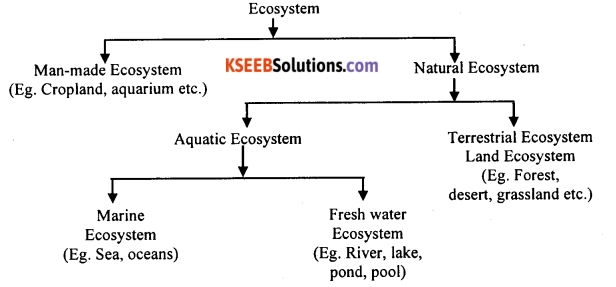
Question 23.
What are natural ecosystems? Give two examples.
Answer:
An ecosystem in which the interactions between its various components are controlled and sustained through natural processes without human intervention is called a natural ecosystem.
E.g.: Forest ecosystem, marine ecosystem etc.
![]()
Question 24.
Give two examples for natural ecosystems.
Answer:
Lakes and forests are examples of natural ecosystems.
Question 25.
Why is a lake considered a natural ecosystem?
Answer:
A lake is a self-supporting system that sustains itself for relatively long durations through natural processes. This is why a lake is a natural ecosystem.
Question 26.
What are artificial ecosystems? Give two examples.
Answer:
Ecosystems created through human effort and which require human intervention to sustain are called artificial ecosystems. Such ecosystems do not possess a self-regulating mechanism. Artificial ecosystems are sometimes called man-made ecosystems.
E.g.: Aquarium, park, agricultural land etc.
Question 27.
Differentiate between natural ecosystem and artificial ecosystem.
Answer:
Natural ecosystems are the result of spontaneous natural reactions and interactions between organizations and their environments. Natural ecosystems occur without the assistance of humans. In a natural ecosystem the animals are free to choose what they eat and drink and the temperature is not artificially controlled. Natural ecosystems contain more natural factors and organisms and hence there is greater diversity.
An artificial ecosystem has controlled factors like what sort of temperature the animals or creatures live in and how much food and water they eat and drink. An artificial ecosystem does not occur by itself and it is designed and controlled by human intervention. An artificial ecosystem is not self- sustaining, and it would perish without human assistance. Artificial ecosystems are simpler and have limited biological diversity.
![]()
Question 28.
Why do we say that an aquarium is an artificial ecosystem?
Answer:
Any ecosystem consists of both biotic and abiotic components. Any system in which both biotic and abiotic components are interdependent and interact with one another is technically called an ecosystem. An aquarium is one such system but made and maintained by human beings. Almost all biological and physical conditions inside an aquarium are controlled by human intervention. Therefore, an aquarium is called an artificial ecosystem.
Question 29.
What are producers, consumers and decomposers?
Answer:
1. Producers:
Organisms that prepare their own food and hence do not depend on other organisms for their food are called producers (autotrophs).
2. Consumers:
Organisms that depend on other organisms for their food are called consumers.
3. Decomposers:
Organisms that break down organic materials such as dead and decaying matter into simpler substances are known as decomposers.
Question 30.
What are autotrophs? Give two examples.
Answer:
Organisms that synthesize their own food are called autotrophs. They are also called producers. E.g.: Green plants and algae.
Question 31.
What is the main means by which autotrophs obtain energy?
Answer:
The main means by which autotrophs obtain energy is photosynthesis.
Question 32.
What is food chain? Give an example.
Answer:
A food chain is the sequence of who eats whom in a biological community (an ecosystem) to obtain nutrition. Thus a food chain represents a succession of organisms that eat another organism and are, in turn, themselves eaten by other organisms. Let us consider a food chain. Deer eats grass. Tiger eats deer. This constitutes a simple food chain.
![]()
![]()
Question 33.
What are trophic levels? Give an example of a food chain and state the different trophic levels in it.
Answer:
The transfer of food or energy takes place through various steps or levels in the food chain. These steps or levels are called trophic levels. The trophic level of an organism is the position it occupies in a food chain. The word ‘trophic’ means ‘food’ or ‘feeding’. Food chains start at trophic level 1 with primary producers such as plants, move to herbivores at level 2, and predators at level 3 and typically finish with carnivores at level 4.
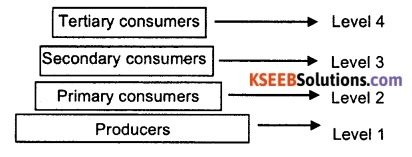
Consider a simple food chain shown in the diagram below:
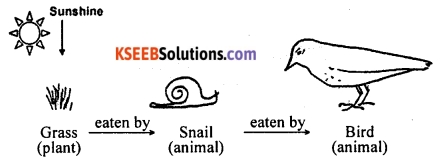
In the food chain given here, grass is a green plant. It uses solar energy and converts it into food. Hence grass is a producer (autotroph). We place grass at trophic level 1. Snail feeds on grass and hence is a primary consumer at trophic level 2. Bird feeds on snail and hence bird is a secondary consumer at trophic level 3.
Question 34.
What is the trophic level of autotrophs?
Answer:
Autotrophs or producers form the first trophic level.
Question 35.
What are heterotrophs? Give two examples.
Answer:
Organisms that depend on other organisms for their food are called heterotrophs. Heterotrophs cannot synthesize their own food and hence will feed on other organisms. Heterotrophs are also called consumers.
E.g.: Cow, tiger, etc.
![]()
Question 36.
How are heterotrophs classified? Give an example for each.
Answer:
Heterotrophs are broadly classified into two types as
- Herbivores and
- Carnivores.
Cow feeds on grass and a few other plants. Therefore, it is an herbivore. Tiger feeds on flesh. Therefore, tiger is a carnivore.
Question 37.
What are herbivores? What is their trophic level? Give two examples for herbivores.
Answer:
Organisms that feed on plants or plant products are called herbivores. They are also called primary
consumers. Herbivores belong to trophic level 2.
E.g.: Cow, goat, sheep, rabbit, etc.
Question 38.
How are consumers classified?
Answer:
Consumers are broadly classified as
- Primary consumers,
- Secondary consumers, and
- Tertiary consumers.
Question 39.
Define:
- Primary consumers,
- Secondary consumers, and
- Tertiary consumers.
Mention the trophic level of each of these.
Answer:
1. Primary consumers:
Organisms that consume or feed on autotrophs (producers) are called primary consumers. Primary consumers are in trophic level 2.
2. Secondary consumers:
Organisms that consume or feed largely on primary consumers as well as autotrophs are called secondary consumers. Secondary consumers are in trophic level 3.
3. Tertiary consumers:
Organisms at the topmost level in a food chain that feed on other carnivores are called tertiary consumers. They belong to trophic level 4.
![]()
Question 40.
What are the different classes of consumers? Define them. Give two examples for each category
of consumers.
Answer:
The various classes of consumers are
- Herbivores,
- Carnivores,
- Omnivores,
- Detrivores,
- Decomposers,
- Parasites.
1. Herbivores:
Heterotrophic organisms that feed on plants or plant products are called herbivores. They are also called primary consumers.
E.g.: Cow, rabbit, butterfly etc.
2. Carnivores:
Heterotrophic organisms that feed on other animals are called carnivores. These are animals which get their food by eating other animals,
E.g.: Wolf, lion, tiger, hawk etc.
3. Omnivores:
Heterotrophic organisms that can feed on food from both plant and animal sources are called omnivores.
E.g.: Human beings, dog, cockroach, ants etc.
4. Detrivores:
Heterotrophic organisms that feed on organic matter present in dead plants and animals are called detrivores.
E.g.: Earthworm, millipedes, dung beetles, etc.
5. Decomposers:
Heterotrophic organisms that derive energy by decomposing organic matter are called decomposers.
E.g.: Bacteria, fungi etc.
6. Parasites:
Heterotrophic organisms that live and feed on or in an organism of a different species and cause harm to the host are called parasites.
E.g.: Tapeworm, plasmodium etc.
Question 41.
What is (the trophic level of the following organisms: Tiger, Adult frog, Algae, Eagle, Butterfly?
Answer:
- Tiger: Trophic level 4 (Tertiary consumer)
- Adult frog: Trophic level 3 (Secondary consumer)
- Algae: Trophic level 1 (Producer)
- Eagle: Trophic level 4 (Tertiary consumer)
- Butterfly: Trophic level 2 (Primary consumer).
![]()
Question 42.
Draw a schematic diagram of a simple food chain.
Answer:
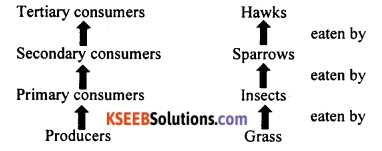
Question 43.
How does the number of organisms vary with the trophic level? At which trophic level of an ecosystem do you find the highest number of organisms?
Answer:
Generally a higher number of organisms are found at the lower trophic levels of an ecosystem. For instance, the number of organisms at trophic level 4 is smaller than the number of organisms at trophic level 3.
Similarly the number of organisms at trophic level 3 is smaller than the number of organisms at trophic level 2. However, we find highest number of organisms among producers (autotrophs) which form trophic level 1.
Question 44.
At which trophic level do we place foxes?
Answer:
Foxes generally eat rabbits. Rabbits are at 2nd trophic level. Hence we place foxes at the 3rd trophic level. Thus foxes are secondary consumers.
Question 45.
Where do you place eagle in the trophic level? Why?
Answer:
Eagle feeds on snakes and foxes, which are at the 3rd trophic level. Therefore, eagle belongs to the 4th trophic level. Thus eagle is a tertiary consumer.
Question 46.
What is the trophic level of human beings?
Answer:
Human beings derive nutrition by eating both plant and animal products. A vegetarian human being is a primary consumer while a non-vegetarian human being could be considered a tertiary consumer.
Question 47.
Draw a pyramid showing the various trophic levels in an ecosystem.
Answer:
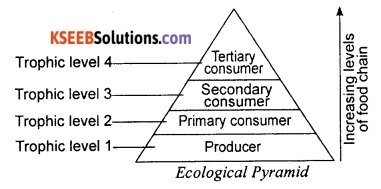
Question 48.
What is ‘energy flow’?
Answer:
Energy is accumulated by the primary producers and is transferred through food chain to different trophic levels. This process is called energy flow.
![]()
Question 49.
State two features of energy flow in an ecosystem.
Answer:
- The flow of energy is unidirectional. As it moves progressively through the various trophic levels, it is no longer available to the previous level.
- The energy available at each trophic level gets diminished progressively due to loss of energy at each level.
Question 50.
Describe briefly the energy flow in nature.
Answer:

In any ecosystem, the primary source of energy is the sun. Producers (usually green plants) use the solar energy to convert inorganic nutrients derived from the environment to make organic molecules. Thus energy gets stored in plants. Thus photosynthesising plants form the first trophic level. Animals that feed on only producers, called herbivores, form the second trophic level.
Here, organisms in the second trophic level derive energy from herbivores. Small predators, which eat up the herbivores, form the third trophic level. These animals derive energy when they eat up organisms at the second trophic level. Large predators, if present, form higher trophic levels. Energy flows into the body of these organisms from the animals that they eat.
Decomposers, which include bacteria, fungi, moulds, worms, and insects, break down wastes and dead organisms and return the nutrients to the soil. At each trophic level a large amount of energy is dissipated in the form of heat. Thus only a small amount of energy gets transferred to higher trophic levels. From the diagram it is clear that flow of energy is unidirectional.
Question 51.
Describe the direction of energy flow in an ecosystem.
Answer:
Sun is the primary source of energy for all ecosystems. Producers trap the solar energy and produce their own food. From the producers, the energy flows to the primary consumers. Next, energy flows from the primary consumers to the secondary consumers. Finally, the energy from the secondary consumers flows to the tertiary consumers. The flow of energy is unidirectional.
![]()
Question 52.
What percent of energy gets transferred to a higher trophic level in an ecosystem?
Answer:
The energy transfer to each higher trophic level is only about 10%. On an average, about 10 percent of net energy production at one trophic level is passed on to the next trophic level.
Question 53.
In the following food chain, how much energy will pass from producers to herbivores and from herbivores to carnivores?
Answer:

In any ecosystem, only about 10% energy is passed from one trophic level to the next higher trophic level. Therefore, in the given food chain, 200 kJ of energy is passed from green plants to herbivores. About 20 kJ of energy is passed from herbivores to carnivores.
Question 54.
The energy transfer to higher trophic level is as low as 10%. Give reason.
Answer:
There are several processes that reduce the energy transferred between trophic levels. These processes include respiration, growth, reproduction, etc. The nutritional quality of material that is consumed also influences how efficiently energy is transferred. During energy transfer from lower trophic level to higher trophic level, lot of energy is lost to the environment in the form of heat. This is why the energy transfer between trophic levels is quite low.
Question 55.
The flow of energy in any ecosystem is unidirectional Explain this statement.
Answer:
The sun is the primary source of energy for ecosystems. The energy that is captured by the autotrophs does not revert back to the solar input and the energy that passes to the herbivores does not come back to autotrophs. As it moves progressively through the various trophic levels, it,is no longer available to the previous level. Therefore, the flow of energy in an ecosystem is unidirectional.
Question 56.
Draw a schematic diagram showing flow of energy in an ecosystem.
Answer:
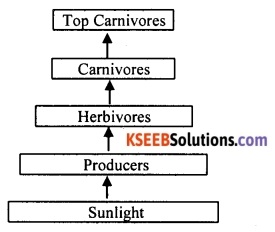
Question 57.
List the characteristics of a food chain.
Answer:
In a food chain:
- There is repeated eating in which each group eats the smaller one and is in turn eaten by the larger one. Thus, it involves a nutritive interaction between the biotic components of an ecosystem;
- There is unidirectional flow of energy from sun to producers and then to a series of consumers of various types. Thus, a food chain is always straight and proceeds in a progressive straight line;
- Usually up to 90% of energy is lost as heat at each transfer;
- Usually there are 4 or 5 trophic levels. Shorter food chains have higher energy transfers and vice versa;
- Omnivores occupy more than one trophic level and some organisms occupy different trophic positions in different food chains.
![]()
Question 58.
What is food web?
Answer:
A complex network of feeding relationships by which energy and nutrients are passed on from one species of living organism to another is known as a food web. A food web is a network of several interlinked food chains.
Question 59.
What is the reason for the formation offood webs in an ecosystem?
Answer:
In any ecosystem, food web is formed because each kind of organism generally eats two or more other kinds of organisms and in turn is eaten by several other kinds of organisms.
Question 60.
Show by a schematic diagram an example of a food web.
Answer:
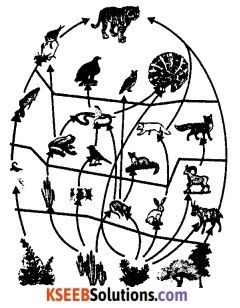
Question 61.
Identify all the food chains in the food web given below:
Answer:
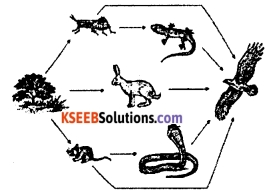
In the diagram given, there are several food chains. The food web shown in the diagram is a network of the following food chains:
Plants → Rat → Snake → Hawk
Plants → Rat → Hawk
Plants → Grasshopper → Lizard → Hawk
Plants → Grasshopper → Hawk
Plants → Rabbit → Hawk.
![]()
Question 62.
List the characteristics of food webs.
Answer:
The following are some of the characteristics of food webs:
- Every food web consists of many food chains.
- Food webs are never straight. They consist of a network of several interlinking food chains.
- Food webs enable the availability of many alternative food options for organisms and hence make the ecosystem stable.
- Food webs help to keep the population of species stable.
Question 63.
Distinguish between food chain and food web.
Answer:
| Food chain | Food web |
| 1. Food chain is a single linear pathway through which food energy and nutrients travel in the ecosystem. | A food web consists of a number of interconnected food chains through which energy and nutrients travel in the ecosystem. |
| 2. In a food chain, an organism of a higher trophic level usually feeds upon a single type of organism of lower trophic level. | In a food web, the members of higher trophic level feed upon many different organisms of lower trophic level. |
| 3. Separate and isolated food chains make the ecosystem relatively unstable. | In a food web, stability of the ecosystem increases due to interconnected complex food chains. |
| 4. Food chains do not contribute to the adaptability and competitiveness of the organisms. | Complex food webs improve the adaptability and competitiveness of the organisms. |
Question 64.
What are decomposers? What is the role of decomposers in the ecosystem?
Answer:
Organisms that break down dead or decaying organisms, and in doing so, carry out the natural process of decomposition of organic matter are called decomposers. Decomposers break down dead remains of plants and animals. By doing so, they serve two purposes. First, they reduce the burden on the environment by clearing dead remains. Secondly, they channelize the raw materials back to the environment.
Question 65.
Why do we consider bacteria and fungi as decomposers?
Answer:
Bacteria and fungi break down complex organic matter into simple molecules and return them to the environment. They derive energy for their survival in the process of decomposition of organic matter. This is why bacteria and fungi are considered as decomposers.
![]()
Question 66.
Growth of thread-like structures along with the gradual spoilage of tomato can be observed when a cut tomato is kept aside for four days. Interpret the causes for this change.
Answer:
We see the growth of thread-like structures on cut pieces of tomato after about four days. This is due to the growth of microorganisms such as fungus. The fungus is most likely to be Hyphae of Rhizopus (Bread mould).
The spores of Rhizopus begin to grow on a cut piece of tomato as it provides favourable conditions for its growth. Fungus is a decomposer. It begins to break down the material of the tomato into simpler materials and hence we see the decaying of tomato.
Question 67.
A student places a piece of cucumber, a glass piece, a banana peel and a plastic pen in a pit and closes it. What changes can be observed in these materials after a month? Give scientific reason for these changes.
Answer:
The student has placed both biodegradable and non-biodegradable materials in the pit. Cucumber pieces and banana peel are organic materials and hence are biodegradable. They are broken down into simpler substances by the activity of microbes.
This decomposition turns them into organic manure. Glass piece and plastic pen are non-biodegradable. They remain in the pit without undergoing any change even after a month. They cause soil pollution.
Question 68.
What will happen if we kill ail the orsanisms in one trophic level?
Answer:
Removal of all the organisms of a trophic level will affect the entire ecosystem. All organisms in higher trophic levels will perish from the ecosystem as they die of starvation. The population of organisms in the immediate lower trophic level will increase. If autotrophs, which form the base of the food pyramid, disappear, all other organisms on earth will disappear.
Question 69.
Will the impact of removing all the orsanisms in a trophic level be different for different trophic levels? Can the organisms of any trophic level be removed without causing any damage to the ecosystem?
Answer:
Yes. The impact of removing all organisms in a trophic level will be different for different trophic levels. The organisms at higher trophic level will all die for want of food. The organisms in the immediate lower trophic level will increase.
This will put pressure on other trophic levels at the lower end. No. It is impossible to remove organisms of any trophic level without causing any damage to the ecosystem.
![]()
Question 70.
What is biological magnification? Explain with an example. Will the levels of biological magnification be different at different levels of the ecosystem?
Answer:
The phenomenon of increasing concentration of a substance (non-biodegradable chemical) in organisms at successive higher trophic levels in a food chain is called biomagnification. DDT is a non-biodegradable chemical, which is commonly used as a pesticide. It enters the body of plants. The herbivores, which eat up many plants, will have higher concentration of DDT in their body.
Carnivores, which eat up herbivores, will have still higher concentration of DDT in their body. Thus, we observe a gradual increase in the concentration of DDT as we move up in the food chain. This is an instance of biomagnification.
Yes, the levels of biomagnification are different at different levels of the ecosystem. The concentration of chemicals goes on increasing with increase in the trophic level. Highest magnification is found in the highest trophic level.
Question 71.
Observe the figure and answer the given questions.
- Which trophic level has maximum number of organisms? Why?
- In which trophic level are chemicals like DDT accumulated in highest concentration? Why?
Answer:

1. There are generally a greater number of individuals at the lower trophic levels of an ecosystem. The greatest number is of the producers, i.e., T1. This is because the energy that is captured by the autotrophs does not revert back to solar input and the energy which passes to the herbivores does not come back to autotrophs.
2. In trophic level 4, chemicals like DDT are accumulated in higher concentration. The reason is the use of several pesticides and other chemicals to protect the crops from diseases and pests. These chemicals are either washed down into the soil or into the water bodies where they get absorbed.
As these chemicals are not biodegradable, they get accumulated progressively at each trophic level. As human beings occupy the topmost level in the food chain, the maximum concentration of those chemicals gets accumulated in our bodies.
![]()
Question 72.
How does DDT get accumulated at higher trophic levels? Explain.
Answer:
DDT is a non-biodegradable chemical, which is widely used as a pesticide. This chemical enters into the plants through the roots. When herbivores eat these plants, the concentration of DDT in the body of herbivores becomes higher. The secondary consumers eat large number of primary consumers. Thus, the concentration of DDT becomes higher in the secondary consumers. This accumulation continues and eventually, the amount of DDT at the higher trophic level would be the highest.
Question 73.
Why is use of DD T not advised?
Answer:
DDT is a non-biodegradable chemical. Once it enters the food chain, it goes on accumulating at higher trophic levels. It is detrimental to aquatic organisms, birds and human beings. Further, biomagnification disrupts the balance in food chains. It affects the organisms at higher trophic levels including humans. Therefore use of DDT is not advised.
Question 74.
A food chain in a polluted aquatic ecosystem is given. Observe it and answer the following questions.
Fresh water → Algae → Fishes → Birds.
- Which organisms are disturbed more due to biomagnification? Why?
- This ecosystem will be destroyed gradually due to biomagnification. Why?
Answer:
The given food chain is: Fresh water → Algae → Fishes → Birds.
1. In this polluted food chain, the birds are at the highest trophic level. Therefore, the harmful chemical gets accumulated in birds to the highest extent. Thus, the concentration of the chemical is highest in birds. Therefore, birds are the most disturbed due to biomagnification.
2. The chemical causing pollution in the food chain is non-biodegradable. Once the chemical enters the food chain, it will increase its concentration as we go up the trophic level. Some of the organisms may die due to the polluting chemical causing disturbance in the ecosystem. Over a period of time the entire ecosystem may get destroyed.
Question 75.
What is ozone?
OR
What is ozone and how does it affect any ecosystem?
Answer:
A molecule formed by three atoms of oxygen is called ozone. Its molecular formula is O3. Most of the ozone is found in the earth’s atmosphere at higher altitudes between 10 km and 50 km. This is called ozone layer. Ozone layer plays an important role in the ecosystem. The ozone layer wards off harmful ultraviolet radiations from the sun and thus protects the living beings on the earth.
Question 76.
What is ozone layer? How is it helpful?
Answer:
A layer in the earth’s atmosphere at an altitude of 10 – 50 km containing a high concentration of ozone is called ozone layer. The ozone layer protects the life forms on earth by absorbing the most harmful ultraviolet radiation reaching the earth from the sun.
![]()
Question 77.
How is ozone formed in the earth’s atmosphere? Explain.
Answer:
Ozone at the higher levels of the atmosphere is formed as a result of action of ultraviolet radiation
on oxygen molecules (O2). UV radiation emitted by the sun is high-energy radiation. It acts on oxygen molecule and splits it into two oxygen atoms.
![]()
Oxygen atom is highly reactive. It combines with a molecule of oxygen to form ozone molecule. (Oxygen molecule) + (Oxygen atom) → Ozone molecule
O2 + O → O3
Question 78.
Which is the natural filter of dangerous ultraviolet radiation emitted by the sun?
Answer:
Ozone layer present in the earth’s atmosphere acts as natural filter and prevents the dangerous ultraviolet rays from reaching the earth’s surface.
Question 79.
Name the chemicals that are harming the ozone layer that surrounds the earth.
OR
Find out the chemicals that are responsible for the depletion of the ozone layer.
Answer:
The chief group of chemicals that is depleting the ozone layer is called chlorofluorocarbons (CFCs). The others include a group of chemicals called halons, methyl bromide, and methyl chloroform. In general, any chemical that releases either chlorine or bromine to the earth’s atmosphere will harm the ozone layer.
Question 80.
What are chlorofluorocarbons? Name some of the uses of this group of chemicals.
Answer:
Chlorofluorocarbons are a group of chemicals whose molecules are made up of atoms of carbon, fluorine and chlorine.
Chlorofluorocarbons are used in many industries and products that include refrigeration industry, air conditioners, solvents, foam industry, inhalers and aerosols.
Question 81.
What are the consequences of depletion of ozone layer?
Answer:
Depletion of the ozone layer has dangerous consequences for life forms on earth. When ozone layer thins out, the harmful UV radiation reaches the earth. This can lead to
- Increased incidents of skin cancer,
- Increase in instances of premature cataract,
- Destruction of minute forms of life,
- Decrease in agricultural yield and so on.
Question 82.
Why is damage to the ozone layer a cause for concern? What steps are beiite taken to limit this damage?
Answer:
Ozone layer works like a protective shield for living beings. The ozone layer protects th£ life forms on earth from harmful ultraviolet radiation emitted from the sun. Damage to the ozone layer can result in increased level of ultraviolet radiations in our atmosphere and they can easily reach the earth. This would be very dangerous for all life forms.
In 1987, the UNEP (United Nations Environment Programme) succeeded in forging an agreement among different nations to freeze the CFC production at 1986 levels. It is now mandatory for all manufacturing companies to make CFC-free refrigerators throughout the world.
Question 83.
Name some materials that can be recycled.
Answer:
Recyclable wastes include scrap glass, paper, thermoplastics, metal scrap etc.
![]()
Question 84.
Why was the proposal to use disposable mud cups (kulhads) in trains given up?
Answer:
Using mud cups in the place of plastic cups requires making of mud cups on a large scale. Making mud cups on a large scale results in loss of fertile topsoil. This is neither desirable nor environment-friendly. This is why the proposal to use mud cups as an alternative to plastic cups was abandoned.
Question 85.
Suggest some measures of safer disposal of wastes.
Answer:
The following are some of the safer methods of disposal of wastes:
- The biodegradable and non-biodegradable wastes must be segregated and collected separately.
- Biodegradable wastes may be converted into organic manures, biogas etc.
- Solid wastes, which are not recyclable, may be buried as landfills.
- Some solid wastes such as glass, plastic, paper, metals etc., must be recycled.
- Toxic wastes from hospitals must be burnt at high temperature to reduce their volume and to kill pathogens.
- Industrial effluents must be treated to free them of pollutants before letting the water to the environment.
Fill In The Blanks
1. The class of compounds that are chiefly responsible for the depletion of the ozone layer is Chlorofluorocarbons
2. Green plants synthesize their own food. Hence they are called producers/autotrophs
3. Animals which eat both plant and animal matter are known as omnivores
4. A tri-atomic molecule of oxygen is called ozone
5. Herbivores are also called primary consumers
6. Every food chain starts with a producer
7. The living components of an ecosystem are called biotic factors
8. The non-living components of an ecosystem are called abiotic factors
9. The energy transfer from one trophic level to the next is about 10%
10. Plastic, glass, DDT are examples of materials that are non-bidegrdable
![]()
Multiple Choice Questions
Question 1.
Which of the following groups contains only biodegradable items?
(A) Grass, DDT and flowers
(B) Grass, wood and plastic
(C) Fruit-peels, cake and glass
(D) Cake, wood and grass
Answer:
(D) Cake, wood and grass
Question 2.
Which of the following constitutes a food chain?
(A) Grass, wheat and mango
(B) Grass, goat and human
(C) Goat, cow and elephant
(D) Grass, fish and goat
Answer:
(B) Grass, goat and human
Question 3.
Which of the following are environment-friendly practices?
(A) Carrying cloth-bags to put purchases in while shopping
(B) Switching off unnecessary lights and fans
(C) Walking to school instead of getting your mother to drop you on her scooter
(D) All of the above
Answer:
(D) All of the above
![]()
Question 4.
Which one of the following is an artificial ecosystem?
(A) Pond
(B) Crop field
(C) Lake
(D) Forest
Answer:
(B) Crop field
Question 5.
In a food chain, the third trophic level is always occupied by
(A) carnivores
(B) herbivores
(C) decomposers
(D) producers
Answer:
(A) carnivores
Question 6.
An ecosystem includes
(A) all living organisms
(B) non-living objects
(C) both living organisms and non-living objects
(D) sometimes living organisms and sometimes non-living objects
Answer:
(C) both living organisms and non-living objects
Question 7.
In the food chain given, suppose the amount of energy at fourth trophic level is 5 kJ, what will be the energy available at the producer level:
Grass → Grasshopper → Frog → Snake → Hawk?
(A) 5 kJ
(B) 50 kJ
(C) 500 kJ
(D) 5000 kJ
Answer:
(D) 5000 kJ
![]()
Question 8.
Depletion of ozone is mainly due to
(A) chlorofluorocarbons
(B) carbon monoxide
(C) methane
(D) pesticides
Answer:
(A) chlorofluorocarbons
Question 9.
Organisms which synthesise carbohydrates from inorganic compounds using radiant energy are called
(A) decomposers
(B) producers
(C) herbivores
(D) carnivores
Answer:
(B) producers
Question 10.
Which food chain correctly describes the flow of energy in an ecosystem?
(A) Grass → goat → human
(B) Caterpillar → leaf → human
(C) Cow → grass → human
(D) Leaf → bird → caterpillar
Answer:
(A) Grass → goat → human
Question 11.
In an ecosystem, the 10% of energy available for transfer from one trophic level to the next higher trophic level is in the form of
(A) heat energy
(B) light energy
(C) chemical energy
(D) mechanical energy
Answer:
(C) chemical energy
![]()
Question 12.
Organisms of a higher trophic level which feed on several types of organisms belonging to a lower trophic level constitute the
(A) food web
(B) ecological pyramid
(C) ecosystem
(D) food chain
Answer:
(A) food web
Question 13.
The decomposers in an ecosystem
(A) help disperse seeds for plant growth.
(B) break down organic matter and return nutrients to the environment.
(C) do not help other organisms in an ecosystem.
(D) use the sunlight to synthesize their food.
Answer:
(B) break down organic matter and return nutrients to the environment.
Question 14.
Producers in an ecosystem derive energy for their needs from
(A) carnivores
(B) herbivores
(C) green plants
(D) the sun
Answer:
(D) the sun
Question 15.
Flow of energy in an ecosystem is always
(A) unidirectional
(B) bidirectional
(C) multi-directional
(D) no specific direction
Answer:
(A) unidirectional
![]()
Question 16.
Accumulation of non-biodegradable pesticides in the food chain in increasing amount at each higher trophic level is known as
(A) eutrophication
(B) pollution
(C) biomagnification
(D) accumulation
Answer:
(C) biomagnification
Question 17.
Which of the following limits the number of trophic levels in a food chain?
(A) Decrease in energy at higher trophic levels
(B) Deficient food supply
(C) Polluted air
(D) Water
Answer:
(A) Decrease in energy at higher trophic levels
Question 18.
Animals that eat both plants and animals are called
(A) detrivores
(B) carnivores
(C) omnivores
(D) herbivores
Answer:
(C) omnivores
Question 19.
High energy ultraviolet rays emitted by the sun are responsible for increased incidences of
(A) colour blindness
(B) lung cancer
(C) kidney failure
(D) skin cancer
Answer:
(D) skin cancer
Question 20.
Which of the following statements is incorrect?
(A) All green plants and blue green algae are producers.
(B) Green plants get their food from organic compounds.
(C) Producers prepare their own food from inorganic compounds.
(D) Plants convert solar energy into chemical energy.
Answer:
(B) Green plants get their food from organic compounds.
![]()
Match The Following
Question 1.
| Column A | Column B |
| 1. Sun | a. Earthworm |
| 2. Herbivore | b. Non-biodegradable |
| 3. Green plants | c. Feed on plants |
| 4. Carnivore | d. Producers |
| 5. Detrivore | e. Trophic level |
| 6. DDT | f. Ultimate source of energy |
| g. Feeds on other animals |
Answer:
1 – f, 2 – c, 3 – d, 4 – g, 5 – a, 6 – b.